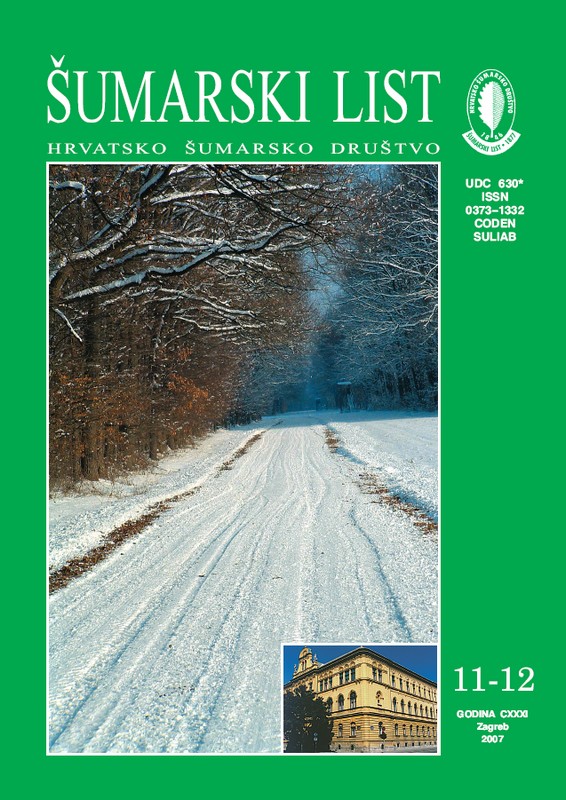
broj: 11-12/2007
pdf (28,4 MB) |
|
||||||||||||||
| IZVORNI ZNANSTVENI ČLANCI | ||
| Pernar, R., M. Ančić, A. Seletković | UDK 630* 429 + 453 (001) | |
| Application of Colour Infrared Aerial Photographs for the Assessment of Forest Damage in the Gospić Forest Administration pdf HR EN | 507 | |
| Kajba, D., N. Pavičić, S. Bogdan, I. Katičić | UDK 630* 165 (001) | |
| Pomotechnical Treatments in the Broadleave Clonal Seed Orchards pdf HR EN | 523 | |
| Ivanković, M. | UDK 630* 165 (001) | |
| Posibility of Genetical Introgresion of Nordmann fir (Abies nordmaniana /Steven/ Spach) in Common Fir Forests (Abies alba Mill.) of Macelj and Trakošćan pdf HR EN | 529 | |
| PREGLEDNI ČLANCI | ||
| Margaletić, J., V. Jurjević, M. Glavaš, B. Hrašovec, D. Diminić | UDK 630* 453 | |
| The Analises Extermination of Gypsy Moth (Lymantria dispar L.) in the 2005 Year of Croatian State Forests pdf HR EN | 539 | |
| Dasović, M. | UDK 630* 907.1 + 907.2 : 652 | |
| Biological-Ekological and Spatial Evaluation of “Laudonov Gaj” Park Forest PDF | 549 | |
| Summary: In order to eliminate the problem of quick sands in Krbavsko Polje, the Forest Office of the First Lika Regiment of Karlovac Generalate made a plan and applied an afforestation technique. Afforestation began in 1746 under the command of Captain (later General) Ernest Gideon Laudon. Seedlings of pedunculate oak (Quercus robur) were planted in holes of 1 m in depth, which were filled with humus from nearby forests. About 10,000 seedlings were planted per hectare. The method of afforestation was prescribed and conducted according to the military system. The army – regiment was shown in a military formation: main force, reserve, lateral, sidelong forces and reconnoitring party. As a token of gratitude, the local people named this forest after Laudon. “Laudonov Gaj” Park Forest, protected over an area of 33.23 ha according to the Nature Protection Act, currently contains 518 old pedunculate oak trees (there were 584 specimen in 1987), with breast diameters ranging from 57 to 153 cm. Most of the trees (377 trees or 72.8 %) have a breast diameter from 81–110 cm, while the majority of them, 157 trees or 30.3 %, are in the diameter class of 91–100 cm. Their height ranges from 8 to 28 m. The majority of the trees are in the height range from 21–24 m. Of 518 trees in all, 51 are broken, whereas 267 (51.5 %) display visibly hollow trunks. From a phytocoenological aspect, the Park Forest is in the zone characterised by the climatozonal community of sessile oak and common hornbeam (Epimedio-Carpinetum betuli Ht.1938/ Borh 1963). In terms of ground vegetation that lacks differentiating species, the culture of pedunculate oak itself is the closest to the community of pedunculate oak and tall broom (Genisto elatae-Quercetum roboris Ht. 1938). Although a very dense cover of seedlings and young growth occurs below the oaks and in the clearings, it perishes after 2–3 years (height of 40 cm), resulting in the absence of the young generation of pedunculate oak in the entire Park area. The edges and clearings are inhabited by a pioneering species of Scots pine (Pinus sylvestris) from the neighbouring cultures. For this reason clearings and gaps will need to be afforested using the park planting method. Seedlings must be older (trained) and 1.5–2 m tall. The biological-ecological, landscaping and historical importance of “Laudonov Gaj” requires an integral interdisciplinary approach to valorisation. It should encompass biological and park-architectural contents and elements. Thus conceived, constructed and maintained, it should find its place in the overall tourist map of the Lika region. Key words: biological-ecological valorisation; Laudonov Gaj; pedunculate oak (Quercus robur); quick sands; recovery.; tourist | ||
| STRUČNI ČLANCI | ||
| Nikolandić, Đ., D. Degmečić | UDK 630* 156 | |
| Recruitment Rate of the Roe Deer (Capreolus capreolus L.) in Baranja Forests pdf HR EN | 565 | |


